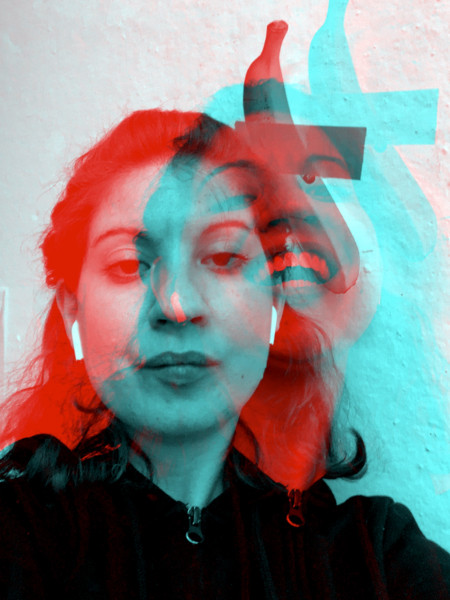
My work lies at the intersection of surveillance, Data, digital presence and care. Over the next year, I will create digital and material artworks that explore how we exist digitally—as both Data and as a human presence on the internet. This includes material objects, such as crocheted fabrications, and digital work made for the web. In addition to making art and research, I will be in conversation and curating from artists in the field. A recent development is that new media artist Roopa Vasudevan has agreed to share work from her project dataDouble as part of my upcoming MFA in Progress show.
This summer I figured out how to crochet a scannable QR code. My first two prototypes failed. Making them felt like writing in a language I don’t understand. I made them both using worsted weight acrylic yarn and changed colors using tapestry crochet. The technique made something that looked like a QR code but did not have the necessary level of definition. My third attempt, however, led to success because I switched to a finer weight of yarn and used intarsia to change colors. The third QR code directs to the blog I kept for class last semester.

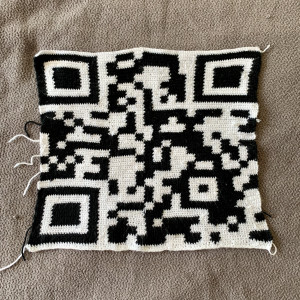
Prototype 1 Prototype 3
Over the first few weeks of this semester, I crocheted a fourth QR code that directs to katymolinaro.com. I was able to purchase the domain this summer using part of my research grant. I am building the website from scratch. I was encouraged to learn how to code in conversations with two visiting artists toward the end of last semester and, after considering my options, I decided to go with the more traditional route of learning HTML, CSS, and JavaScript to implement in creating a customized website.
Because the QR code goes to a space that I control, I will likely use it again and again in different contexts, modifying my website as I go. This QR code one is much sturdier, made from fine black cotton and glow-in-the-dark polyester yarn. A few test scans with my iPhone prove that it is scannable, and it will make its first appearance in my MFA in Progress exhibit, on view November 6–13, 2021. At a minimum, my website will have an online guestbook for exhibition goers to sign, an artist statement, and my contact information.
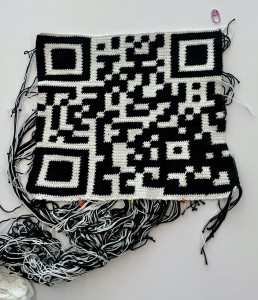
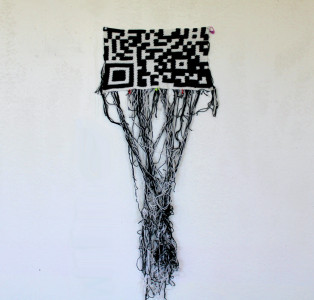
Code for katymolinaro.com Work in progress
In addition to the crocheted QR code, I will offer some preliminary explorations of human digital existence for my MFA in Progress show, which has two sides in my conception: human presence on the internet and Data bodies.
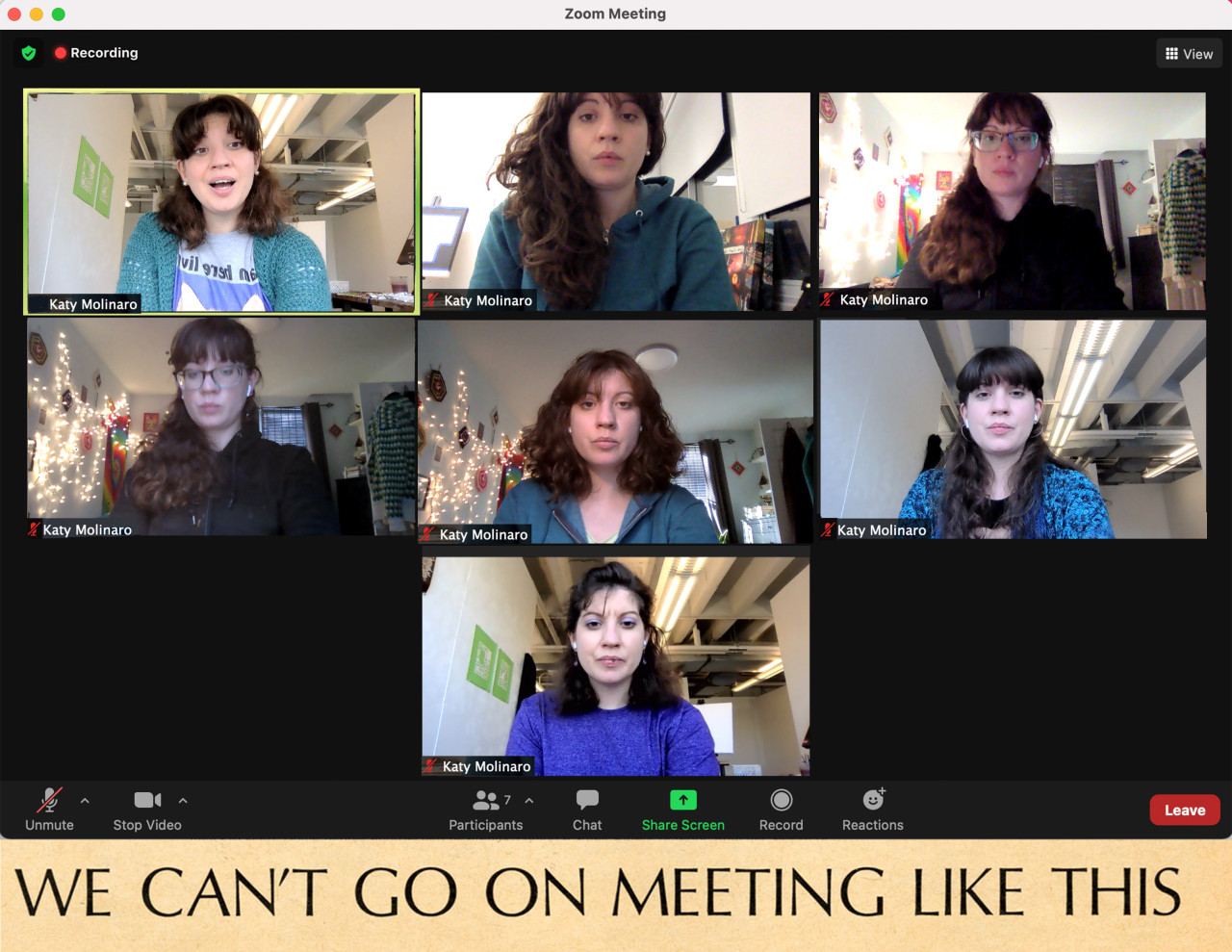
We Can’t Go On Meeting Like This.
Digital collage print (2021)
First, our appearance of being present somewhere by way of the internet, for example on a Zoom call, could be termed digital presence. This presence is special because it is not subject to the same laws of space, time, and causality that affects our material body. When we’re having a meeting on Zoom, for example, we appear in as many different places as there are participants. Though we don’t feel it, in this liminal space we are present in multiple time zones at once.
Thanks to social media, which could be viewed as an archive in flux, we also have agency after we die. Have you ever come across the activity of someone who has passed away on Facebook? How did it make you feel? Although it is not uncommon to come across the belongings of someone who is no longer living, a platform like Facebook broadcasts the digital ‘belongings’ of others (posts, comments, photos, reactions) to their respective public networks. Many have remarked on the way social media ‘flattens’ identity and levels relationships into a common field. I believe this is partly due to the fact that, in the digital realm, content can be created, saved, infinitely duplicated, transferred across the globe in seconds, and, under some conditions, be instantly deleted, though this last point is contested. It is common knowledge that anything created online never really goes away due to the wealth of surveillance practices used to mine our activities and behavior for Data.
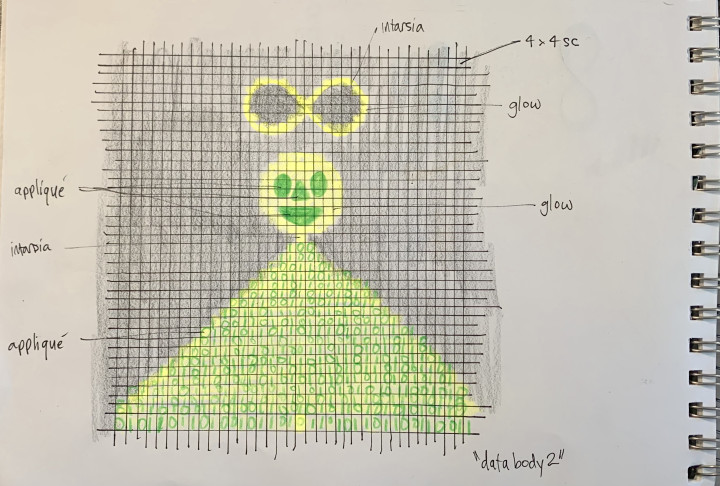
Preliminary sketch for crocheted wall hanging
This brings me to the second facet of how we exist online. We have a Data body that is made up of smaller pieces, but instead of cells and organs, it is composed of data and metadata and it is scattered across the many servers that make up the internet. I plan on exploring the form, function, and agency of the Data body by first attempting to illustrate ways to conceptualize it.
Together these two sides of our digital being, namely the Data body and human digital presence, form the subject of my thesis work at Moore. Being in the Socially Engaged Art program has given me the chance to learn new skills I am eager to acquire, such as web design and programming languages, and has helped me find ways to build upon my current artistic practice, embedding them in a way that is both exciting and relevant.
